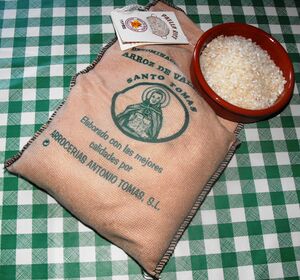Arroz de Valencia

Arroz de Valencia is a DOP rice (Oryza sativa) of the varieties Senia, Bahía and Bomba. It is produced in the wetlands in the provinces of Alicante, Castellón and Valencia.
Documents provide proof that rice was grown in the former Kingdom of Valencia before it was conquered by Jaime I, in 1238. The libre dels repartiments, that divided up the land of the newly conquered kingdom, refers to rice fields. King Fernando VI's regulation of 1753 demarcates the rice-growing fields in the area. Other documents that describe the history of rice-growing in the autonomous community of Valencia are: El arroz (Rice) (1939) Rafael Font de Mora y Llorens, and Compendio arrocero (A compendium of rice) (1952) José Ma Carrasco García. Rice-growing has continued uninterrupted until the present day, with rice constituting an essential ingredient in the cuisine of this region, and one that has international renown, as it forms the basis of Valencian paella.
The rice comes exclusively from plots registered in the Land Plot Register, after having been checked twice during growing. Growers recorded in the register submit a harvest declaration and a sale of harvest declaration, stating the particulars of and signed by the undertaking purchasing the rice. These undertakings must be recorded in the corresponding Register of Ricehandling Undertakings, and must submit monthly reports on movements of the protected rice. These undertakings are inspected three times per year through documentary checks on the origin and quantities of rice handled, and sample-taking to check the quality of the rice. After undergoing these checks, the product is given a numbered label specifying the designation of origin and inspection body.
The autonomous community of Valencia has several natural wetlands (the largest being Albufera) that have the right soil and floodability conditions for the crop, as well as having climatic characteristics suited to rice-growing. Summary of the conditions:
Soil: On both banks of the river Júcar, and in the areas bordering the Albufera, soil is limey in nature (30 to 50 % carbonates), clayey, poor in organic solids and alkaline (pH 8-8,3). The earth is hard and only slightly permeable: optimal physical conditions for rice-growing.
Climate: Temperature, light and humidity conditions in the area of production correspond broadly to those established as optimal for rice-growing in agronomic studies carried out.
The vast majority of rice growers in the autonomous community of Valencia use the direct sowing method, either by hand or from light aircraft. The water level varies in accordance with climatic conditions and crop development. During the growing season, the crop undergoes one or two eixugons (where it is dried out), which consist in leaving it without water for several days to inhibit algae growth. Summary of the process:
Sowing: with centrifugal broadcasters or from a light aircraft. From end of April to mid May.
Harvesting: with mechanised combine-harvesters. From beginning of September to beginning of October.
Drying: on the ground in sequers or forced through hot-air dryers, either once or twice. September and October
Cleaning, milling and packing: entirely mechanised. Throughout the year.